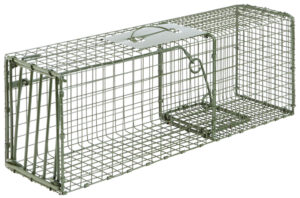Wildlife is unpredictable and can be very dangerous to handle because of the chance of bites, scratching, and spreading diseases. If you prefer to handle things yourself there are many resources on the internet, and most supplies (traps, baits, etc) can be purchased locally and online. This page has a few tips that may help.
IF IN DOUBT, HIRE A PRO. IT’S NOT WORTH THE RISK OF INJURY OR DISEASE TO YOURSELF, KIDS, OR PETS TO SAVE A FEW BUCKS
OFWC IS NOT RESPONSIBLE IF YOU FOLLOW THESE TIPS AND GET YOURSELF IN TROUBLE
KNOW AND FOLLOW ALL LOCAL, STATE AND FEDERAL WILDLIFE LAWS
Cage Traps
- Identify the exact species of the animal causing trouble and use the appropriate trap. A coon trap won’t catch a packrat, a squirrel trap won’t catch a coon, etc
- Traps from the local hardware or farm supply store are adequate but not for repeated use. A raccoon is extremely strong and can break out of weak traps. For repeated use, purchase professional, high-quality traps.
- Traps should be sturdy and not wobble. If an animal steps inside of a trap and it moves, the animal won’t go in the trap. Traps with square entrances vs rectangular entrances are easier to make stable. If you pin the trap to the ground with tent stakes, rocks, bricks, etc, remember that if you catch a skunk, you’ll have to remove them before you can move the skunk.
- Cover your traps with a cardboard box, tarp, roof shingles, leaves, tree branches, etc to disguise the outline of the cage. Don’t use sheets, blankets, towels, or anything that might have human or pet scent on them
- Cover the floor of the trap with dirt so the animal isn’t walking on the wire
Bait
- To avoid cats but still catch raccoons, opossums, and skunks, use a fruity or sweet bait like chocolate donuts, pop tarts, honey buns, fruit, etc.
- Don’t use cat food or cans of tuna fish, it rots too fast (especially in summer) and is attractive to cats
- Break the bait into small pieces so animals can’t grab the whole thing and leave. This is especially important for raccoons.
- Toss a few soup crackers or pieces of sugar cereal in front of the trap so you can tell if something is visiting but won’t go in the trap
After the Catch
- Animals will pee and poop while being transported and the trap will be dirty, so sit the trap on a tarp, or cardboard or something while in a vehicle
- Be extremely careful releasing animals. When opening the door your hands will be by the business end of the animal. They are fast and don’t know you’re trying to help them.
- Release animals into the wind so they can smell for danger, and away from your car so they’re not tempted to run under or inside of it.
- Raccoons will shoot out of a cage like a rocket, opossums are a little slower but will eventually leave with a purpose, it may take a skunk 5 minutes to decide to leave
- For squirrels, put the trap against a tree so it can immediately climb up
- Release far away from neighborhoods or other houses, businesses, etc. The animal had a horrible experience, has been educated that a trap is bad, and will be much harder to catch if it becomes a problem for someone else.
- Sick or injured animals should not be released into a healthy population.
Summer Heat
- Animals wear their fur coat all year long and don’t do well in hot weather so take precautions to avoid overheating
- Keep traps in the shade and out of the sun
- They won’t like it but pour a bottle of water on them if they appear too hot
- Release animals close to dark when it’s cooling off, they’ve got a lot of work ahead of them to find food and shelter

